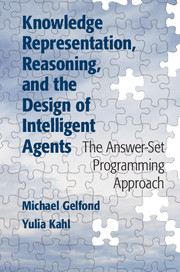 Knowledge Representation, Reasoning, and the Design of Intelligent Agents
Knowledge Representation, Reasoning, and the Design of Intelligent Agents Book contents
- Frontmatter
- Dedication
- Contents
- Preface
- 1 Logic-Based Approach to Agent Design
- 2 Answer Set Prolog (ASP)
- 3 Roots of Answer Set Prolog
- 4 Creating a Knowledge Base
- 5 Representing Defaults
- 6 The Answer-Set Programming Paradigm
- 7 Algorithms for Computing Answer Sets
- 8 Modeling Dynamic Domains
- 9 Planning Agents
- 10 Diagnostic Agents
- 11 Probabilistic Reasoning
- 12 The Prolog Programming Language
- Appendix A ASP Solver Quick-Start
- Appendix B Aspide
- Appendix C Introduction to SPARC
- Appendix D Code
- Bibliography
- Index
6 - The Answer-Set Programming Paradigm
Published online by Cambridge University Press: 05 July 2014
- Frontmatter
- Dedication
- Contents
- Preface
- 1 Logic-Based Approach to Agent Design
- 2 Answer Set Prolog (ASP)
- 3 Roots of Answer Set Prolog
- 4 Creating a Knowledge Base
- 5 Representing Defaults
- 6 The Answer-Set Programming Paradigm
- 7 Algorithms for Computing Answer Sets
- 8 Modeling Dynamic Domains
- 9 Planning Agents
- 10 Diagnostic Agents
- 11 Probabilistic Reasoning
- 12 The Prolog Programming Language
- Appendix A ASP Solver Quick-Start
- Appendix B Aspide
- Appendix C Introduction to SPARC
- Appendix D Code
- Bibliography
- Index
Summary
So far we have used our ASP knowledge bases to get information about the truth or falsity of some statements or to find objects satisfying some simple properties. These types of tasks are normally performed by database systems. Even though the language's ability to express recursive definitions and the methodology of representing defaults and various forms of incomplete information gave us additional power and allowed us to construct rich and elaboration-tolerant knowledge bases, the types of queries essentially remained the same as in databases.
In this chapter we illustrate how significantly different computational problems can be reduced to finding answer sets of logic programs. The method of solving computational problems by reducing them to finding the answer sets of ASP programs is often called the answer-set programming (ASP) paradigm. It has been used for finding solutions to a variety of programming tasks, ranging from building decision support systems for the Space Shuttle and computer system configuration to solving problems arising in bio-informatics, zoology, and linguistics. In principle, any NP-complete problem can be solved in this way using programs without disjunction. Even more complex problems can be solved if disjunctive programs are used. In this chapter we illustrate the ASP paradigm by several simple examples. More advanced examples involving larger knowledge representation components are discussed in later chapters.
There are currently several ASP inference engines called ASP solvers capable of computing answer sets of programs with millions of ground rules.
- Type
- Chapter
- Information
- Knowledge Representation, Reasoning, and the Design of Intelligent AgentsThe Answer-Set Programming Approach, pp. 114 - 130Publisher: Cambridge University PressPrint publication year: 2014
- 2
- Cited by


